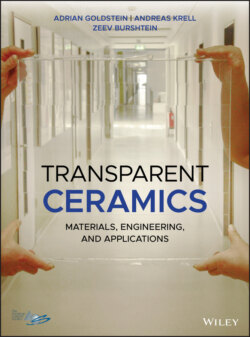Читать книгу Transparent Ceramics - Adrian Goldstein - Страница 19
1.3.1 High Transmission Spectral Domain
ОглавлениеMany natural or human-caused physical processes are accompanied by emission or absorption of electromagnetic waves, carrying different amounts of energy and particularly exhibiting different wavelengths or frequencies. The said wavelength range is named electromagnetic radiation spectrum.
Let us recall that the energy Eph of an electromagnetic wave quantum (photon) is proportional to its frequency ν or to the inverse of its free-space wavelength λ:
(1.1)
where c = λν is the free space speed of light constant and h is Planck constant. The latter are universal constants: c = 2.9979 × 108 m/s and h = 6.626 × 10−34 J s. The wavelength reciprocal is called wave-number. The quantic nature of the electromagnetic field expresses itself particularly during absorption and emission by matter. The electromagnetic wavelength spectrum is virtually infinite and quite broad even in practice (Figure 1.1). In practice means as measured or used by us humans. Even then, it covers about 15 orders of magnitude!
Gamma ray wavelengths range between approximately 1 and 10 Å, while, say, radio waves, may reach and exceed 103 m. Here we cite several examples. A natural process emitting gamma (γ) rays is the decay of excited atomic nuclei and deceleration of charged particles during impacting other particles. X-rays appear, for example, when energetic electrons bombard atoms (this process involves initial ejection of bound electrons, then filling the remaining empty atomic state by an external electron). Particles collision may also involve X-ray emission. Solar activity is a daily source of electromagnetic radiation emission, with frequencies ranging in the ultraviolet (UV), VIS, and IR. Fuel combustion (namely, fast, mainly carbon oxidation) generates mostly near-infrared (NIR) radiation. Electrical currents, based mostly on negative charge movement inside electrical conductors, are used in devices like radio broadcasting or telecommunication systems, which generate electromagnetic radiation in the range of so-called radio waves. Part of the electromagnetic radiation (EMR) generated by the sources described above and others travels around us. A lot of devices need various amounts and spectral segments of this radiation. The transparent ceramics` mission is to select the spectral segment and intensity of the EMR entering some of these devices; they can do this for different spectral segments; the one of interest in this book will be specified below.
When an incident electromagnetic wave (light) hits the surface of a macroscopic solid, it may undergo several processes, classified as reflection, absorption, scattering, and transmission (a part of absorbed light may be re-emitted). The ratios among the said process intensities depend on the physical characteristics of the solid.
Various technological applications require the use of solids that are transmissive to electromagnetic radiation over different segments of the spectrum. For instance, X-ray windows favor low atomic number Z solids; carbon, in the form of a graphite plate, is a reasonable solution. Ceramics often transmit variable fractions of incident electromagnetic radiation in different spectral sections; in other sections they may absorb massively. For instance, beryllium oxide BeO is highly transmissive in the microwave region; thus BeO-based ceramic samples are used for windows there.
This book will not consider all spectral ranges where ceramics exhibit transparency. It focuses on the 0.1 to ∼25 μm range, namely, from the near-ultraviolet(NUV) to the mid-infrared(MIR), that is often addressed as optical region. Electromagnetic radiation in that range is simply addressed as light. The frequency/wavelength range in which a specific material is actually transmissive is termed transparency/transmission window. This means that only ceramics exhibiting significant transmissivity in portions of the range defined above will be considered. Figure 1.2 illustrates transmission windows offered by several already commercially available ceramics; for comparison, the transmission spectra of two popular oxide glasses is also shown (wider transparency glass windows also do exist).
Figure 1.1 Overall wavelength range of the spectrum of EMR (domain to which human eye is sensitive, the VIS, is enlarged in the lower part of the figure).
Source: Reproduced from Shutterstock Images with purchased permission.
The earth atmosphere is transparent [H15] (luckily for us) only to certain ranges of the overall EMR spectrum. It contains various molecules that significantly absorb electromagnetic radiation at various frequencies of the range of interest here. The most important ones are water H2O, carbon dioxide CO2, and to a certain extent also ozone O3. Eventually, the atmosphere is transparent in the VIS and up to about 2.7 μm, with two narrow opaque ranges above about 1 μm. Best transparency in the IR is found in a so-called midwave window, ranging between 3 and 5 μm, and a second, long wavelength window, between 8 and 14 μm. Evidently, transparent ceramics exhibiting transparency overlapping the same regions as the atmosphere would be useful for a host of technological applications.
